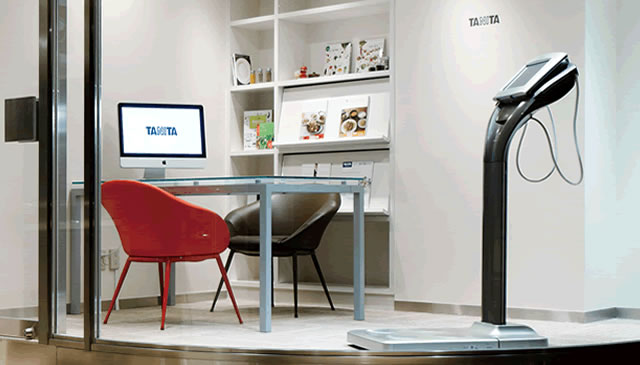[From June Issue 2015]
Tanita
In Japan, every household has a bathroom scale (health meter), and most nowadays keep track of your body composition. Besides your weight, these scales can also measure, body fat percentage, muscle mass, metabolic rate, visceral fat, and more. The history of body composition monitors dates back to the days of bathroom scales and body fat meters. After putting bathroom scales on the market, Tanita Corporation (Itabashi City, Tokyo Prefecture) launched the world’s first scale to measure body fat percentage by simply standing on it.The compan
y was founded in 1944. In those days, rather than producing health monitoring devices, it manufactured metallic products, such as cigarette cases. Before long the company was producing gadgets that were ahead of their time, such as electric kettles, and electric lighters. Then the scales department was founded, and Tanita began selling measuring devices.
Since Tanita was established, the company has capitalized on its technological expertise to launch technology, products, and services that were unprecedented, either in Japan or worldwide. These products included sleep meters to measure quality of sleep and electronic meters to measure urine sugar levels – which are closely related to blood glucose levels. These were all created out of the company’s desire to “promote people’s health by monitoring it.”
The Tanita name has become better known since the publication in 2010 of “The Staff Cafeteria of Tanita, Body Fat Scale Maker” (published by Yamato Shobo). The book contains recipes for meals served at the head office’s staff cafeteria. Comprising of a soup with three side dishes, these set meals contain approximately 500 kilo calories and three grams of salt. Positive feedback from readers can be summarized as follows: “After sticking with this diet, I have a healthier body.”
In 2012, the “Marunouchi Tanita Cafeteria” opened its doors in the Marunouchi business district in Tokyo. The restaurant was created because so many readers had commented that they’d like to eat at the staff cafeteria. A professional spec body composition monitor is installed in the restaurant and a registered dietitian gives health and diet advice based on the measurement results in a consultation room.
Two kinds of meals are available – daily specials or meals that are served according to the day of the week – and just like the staff cafeteria, it’s self-service. The recommended serving of rice is 100 grams. By the effective use of dashi stock and spices and by not over boiling the vegetables, care is taken to ensure that the low calorie count and low salt content does not adversely impact on the taste of the meal.
Fureai Hiroba Plaza within the grounds of Tanita’s head office is open to the public. It has a 150-meter walking and running track and a “Health Trail” with stones of difference shapes that stimulate pressure points on the sole. The space is also used for the benefit of the local community.
Tanita Corporation
Text: ITO Koichi[2015年6月号掲載記事]

タニタ
日本ではどの家庭にも体重計(ヘルスメーター)がありますが、今は体組成計が主流です。体重以外に体脂肪率や筋肉量、基礎代謝量や内臓脂肪レベルなどをはかることができます。体組成計の歴史は体重計、体脂肪計にさかのぼります。株式会社タニタ(東京都板橋区)は体重計を発売後、世界初の、乗るだけではかれる体脂肪計を発売しました。
同社の設立は1944年。当時は健康計測機器ではなく、シガレット・ケースなどの金属加工メーカーでした。やがて電気ポットや電子ライターなど、時代を先取りするさまざまな商品を次々に手掛けました。さらに、はかり事業部を設置し、はかる商品を発売してきました。
タニタは設立以来、独自の技術力を高め、日本初・世界初の技術や商品、サービスなどを世の中に送り続けてきました。たとえば、睡眠の状態をはかる睡眠計、血糖値と関係の深い尿糖値をはかる電子尿糖計があります。どれも「はかる」を通して人々の健康づくりに貢献するという同社の願いから生まれたものばかりです。
タニタの名前がより一層知られるようになったのは、2010年に発行された本「体脂肪計タニタの社員食堂」(大和書房発行)でした。これは本社の社員食堂のメニューをまとめたレシピ本です。どれも一汁三菜の定食スタイルで500キロカロリー前後、塩分3グラム前後。「続けて食べることで健康的な体に変わった」などの声が寄せられました。
2012年にはビジネス街である東京・丸の内に「丸の内タニタ食堂」がオープンしました。多くの読者から、社員食堂で食べてみたいという声が寄せられたからです。ここでは、プロフェッショナル仕様の体組成計を設置し、管理栄養士が計測結果と健康と食事に関するアドバイスをするカウンセリングルームがあります。
ここで出されるメニューは日替わりと週替わりの2種類で、社員食堂と同じセルフサービス式。ごはんは100グラムをすすめています。だしやスパイスをきかせたり野菜をゆで過ぎないようにしたりすることで、カロリーや塩分が低くてもおいしさを損なわない工夫をしています。
本社内の敷地にはふれあい広場があり、一般に開放しています。ウオーキングやジョギングが可能な1周約150メートルのコースや、形の異なる石を敷き詰め足のつぼを刺激する「健康小径」などが設けてあります。地域貢献の場としても利用されています。
株式会社タニタ
文:伊藤公一
Information From Hiragana Times
-
 April 2024 issue is now on sale!March 19, 2024
April 2024 issue is now on sale!March 19, 2024 -
 March 2024 issue is now on sale!February 19, 2024
March 2024 issue is now on sale!February 19, 2024 -
 February 2024 issue is now on sale!January 22, 2024
February 2024 issue is now on sale!January 22, 2024
Topics in Japan
-
 With Prayers and Wishes for NotoApril 19, 2024
With Prayers and Wishes for NotoApril 19, 2024 -
 オヤカク – Confirm with ParentsApril 11, 2024
オヤカク – Confirm with ParentsApril 11, 2024 -
 English Words are Increasingly Used in Everyday LifeApril 9, 2024
English Words are Increasingly Used in Everyday LifeApril 9, 2024 -
 A Daily-evolving, Incredibly Delicious RamenApril 4, 2024
A Daily-evolving, Incredibly Delicious RamenApril 4, 2024 -
 Aiming to be “be looked up to by the grandchildren”March 19, 2024
Aiming to be “be looked up to by the grandchildren”March 19, 2024
Topics in Japane Category
- Business (117)
- Entertainment (78)
- Events (4)
- Food (45)
- Highlights (546)
- Hot Events (2)
- Language (49)
- Living (9)
- People (113)
- Society (154)
- Spots (1)
- Travel (80)
Products
-
 Print version ¥9,900 – ¥46,900
Print version ¥9,900 – ¥46,900 -
 APP Version ¥7,200 – ¥29,900
APP Version ¥7,200 – ¥29,900 -
 APP+Print Version ¥13,900 – ¥49,900
APP+Print Version ¥13,900 – ¥49,900